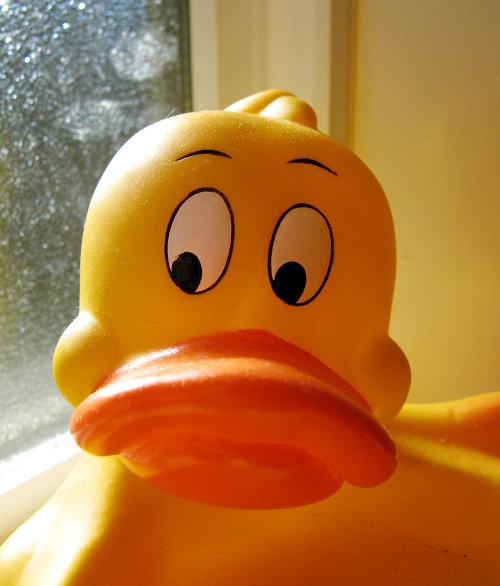[/caption]NASA scientists have dropped 90 yellow rubber ducks into holes in Greenland’s Jakobshavn glacier in an attempt to understand why glaciers speed up during summer months as they slip into the sea. The ducks, attached to a football-sized probe, have an email address and message prompting anyone who discovers the ducks to contact NASA to reveal where and when the duck was found. There is an undisclosed award for anyone who finds one of these rubber global warming crusaders. The NASA scientists, based at the Jet Propulsion Laboratory (JPL) in California, hope this campaign will shed new light on the melting mechanisms behind Greenland’s fastest moving glacier…
This story brings back memories of when 30,000 rubber ducks were washed off a cargo ship bound for the US from China back in 1992. Since then, these intrepid explorers have travelled on the world’s ocean currents, ending up as far afield as the middle of the Pacific to the coast of England. Although they have lost their yellow colouring after years of high seas and Sun damage, the duck-shaped pieces of plastic have provided scientists with a valuable insight into ocean circulation and are still found on beaches today. They have also become a commodity (changing hands for over £500 or $1000), been the focus of children’s story books and provided data for a computer model called the Ocean Surface Currents Simulation (used to help fisheries and find people lost at sea). So, in the footsteps of their forefathers, these new NASA rubber recruits hope to provide climatologists with information about the current global warming trend and impacts on polar ice.
Alberto Behar, one of the JPL scientists working with the army of rubber ducks explains, “Right now it’s not understood what causes the glaciers themselves to surge in the summer.” The rubber ducks will help to tackle this problem by carrying a probe with them so their progress can be tracked via GPS. The football sized probe will also relay information about the glacier’s innards as the rubber ducks flow with the ice into the sea.
So far, nobody has reported finding a duck or a probe, but Behar is hopeful that a fisherman or hunter might do in the near future. “We haven’t heard back but it may take some time until somebody actually finds it and decides to send us an e-mail that they have found it,” he said. “These are places that are quite remote so there aren’t people walking around.” Let’s hope the promise of a reward will be enough incentive for the finder to make contact with NASA (otherwise we might see them being advertised on eBay for £500 or $1000…).
The Jakobshavn Glacier is famous in its own right. The iceberg that sank the Titanic in 1912 is thought to originate from it and the glacier has a phenomenal ice discharge rate today, responsible for nearly 7% of the ice flowing from Greenland.
Sources: The Sydney Morning Herald, Times Online (from June 28th, 2007)


Hmm . . . at least this doesn’t appear to be a hundred million dollar project. Or is it?
I’d say that the fact that when you have sunshine and warmer temperatures in the summertime might have something to do with the glacier speeding up.
I wonder what is the most unexpected place to find this little duck?????
I’d say Jupiter
Wouldn’t it be a lot easier if they just monitored the ducks 24/7 via GPS?
Interesting experiment, but seriously, what about all the ‘litter’ they’re causing with all those undiscovered rubber duckies :/
And yeah, I’m sure animal activists would be opposed to this – causing maybe choking hazards in some big animals thinking it’s food.
Maybe they were made biodegradable?
If this were April 1st, I would have expected an article like this.
I can’t believe our taxes are going to be paying for this? Ask a 5th grader why glaciers speed up during the summer. It doesn’t take too many brain cells to figure it out.
This is ridiculous, there are probably a lot of sea animals that think they are food and being poisoned 🙁
Has anyone come across tax-payer cost for this nonsense?
just wondering if anyone figured out that global warming is caused by pulling oil out of the ground the earth is like a car if you take oil out of a car then it overheats same as the earth. so what good is all the other testing too much money spent and still playing with rubber ducks go figure
That rubber duck looks pensive and kind of sad…
Or maybe he’s contemplating the frigid water he’ll be swimming in soon…
I think it is highly appropriate that such a prestigious scientific organization should use rubber duckies to study Global Warmi…I’m sorry, my bad, Climate Change.
After all, the Big Bird in charge of NASA’s division that propagates this dubious politically correct “theory” is a quack.
I still can’t decide what is worse the fact they are using rubber ducks or the fact they got approval to do this
Relax, people!
It’s publicity. Outreach. Call it what you want. I cutesy way to engage the public in research.
Damn. And if they hadn’t done it this way some woulda accused them of being insulated ivory-tower elitists.
Do you really think it’s that much more expensive to attach a rubberduck to the probes? Or should they just have skipped the probes and bought more duckies instead?
Whiners.